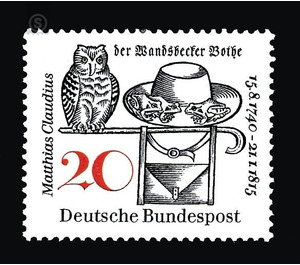150th anniversary of death of Matthias Claudius - Germany / Federal Republic of Germany 1965 - 20
Theme: Animals
| Country | Germany / Federal Republic of Germany |
| Issue Date | 1965 |
| Face Value | 20.00 |
| Color | black white |
| Perforation | K 14 |
| Printing Type | 2-color Typography |
| Stamp Type | Postage stamp |
| Item Type | Stamp |
| Chronological Issue Number | 352 |
| Michel ID | BRD 462 |
| Chronological Chapter | GER-BRD |
| SID | 835470 |
| In 56 Wishlists | |
Matthias Claudius, who entered the history of literature as Wandsbecker's messenger, was born on August 15, 1740, in Reinfeld near Lübeck and died on January 21, 1815. On the occasion of the 150th anniversary of his death, the Deutsche Bundespost publishes this commemorative stamp. The graphic designers invited to edit drafts were free to either use the portrait or to use pictorial elements from the works of Matthias Claudius. A solution of the second kind was obvious, because the poet's world of ideas is rich in images. She has inspired masters of the rank of a Chadowiecki to interpret them graphically. For both intentions the artists received suitable picture documents. Holger Börnsen, Prof. Walter Breker, Karl Oskar Blase and graphic designer Hans Förtsch and Sigrid von Baumgarten each sent a draft, while Reinhart Heinsdorff, Prof. Rolf Lederbogen and Horst A. Rischka each contributed three proposals. The graphics couple Gerd and Erika Aretz participated with four, Wilhelm Neufeld with six works. These 23 sketches contain six pure portraits and four works centered around a portrait silhouette. Four further leaves transform a free illustration with the figure of the Wandsbecker messenger in different versions. Furthermore, two essays deal with the topic "moon" in a very ornamental form, while another paper was submitted as a pure typeface solution. The remaining six suggestions are based on the original illustrations found in contemporary editions. The two proposals, which seem to radiate the very essence of Claudius's pondering and feeling, first came to the fore. The black portrait silhouette in front of the violet-velvety celestial ground is crowned by the numeral, in which the zero is actually the crescent of the moon added to the circle - a tangible and imaginative link to the classical evening song. The other solution combines two typical woodcuts from the illustrated work in a cheerful play to a narrative unit that looks like a Bilderrebus. The wide-brimmed hat with the toads complements the messenger's staff, to which the traveling bag hangs. The owl, which has usually settled on this hat, sits here off to the end of the stick, thus balancing the composition. The text of the stamp is divided into four lines, which loosely indicate the brand edge. In order to emphasize the narrative note of the brand more, it was decided not to put the drawing on a colored background. Rather, text and vignette are printed in black on a slightly gray-tinted paper, while the value number is the only element that gives a colorful accent. It is interesting to keep track of how the design has evolved to its mature form. Bundesdruckerei Berlin provided printing in two-tone intaglio after the Federal Minister for Posts and Telecommunications had given his consent to the proposals of the Art Advisory Council.
| Condition | Name | In Stock | Price | Price + Shipping | Store | |
|---|---|---|---|---|---|---|
 | Used | 150th anniversary of death of Matthias Claudius - Germany / Federal Republic of Germany 1965 - 20 | 10 | US $0.217 | US $3.46 |  FILATELIELOKET (0) FILATELIELOKET (0)Shipping US $3.25 Minimum Order US $2.72 |
 | Unmounted Mint ** | 150th anniversary of death of Matthias Claudius - Germany / Federal Republic of Germany 1965 - 20 | 10 | US $0.326 | US $3.57 |  FILATELIELOKET (0) FILATELIELOKET (0)Shipping US $3.25 Minimum Order US $2.72 |


